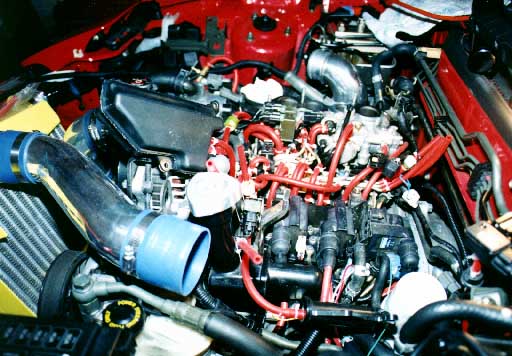How To Remove the Intake Extension Manifold
By Rob Robinette
 < Convert this web page to Palm Pilot Doc format
< Convert this web page to Palm Pilot Doc format
A lose vacuum hose is a pretty common occurrence on the 3rd gen RX-7
and to get to most of them you'll have to remove the extension manifold. Pulling it off
exposes a lot of stuff and makes a lot of other jobs much easier. You might want to
consider doing the following while the intake extension manifold is off: Replace the
vacuum hoses, spark plugs, plug wires, install an ignition amplifier (Crane Hi-6, etc.),
install a manual boost controller, hook up a wire to the trailing coil for a shift light,
and have the extension manifold polished (looks very cool). Access to all these components
is much easier with the manifold off.

Intake elbow and throttle body
removed, extension manifold in place
Start by removing the strut tower brace if you have one. Remove the
air pipes that go from the air cleaner to the turbo inlets and the air pipe that runs from
the turbos, past the alternator, to the intercooler. Remove the intake elbow pipe that
attaches to the throttle body by removing its 4, 10mm chrome cap nuts, hose clamp and 1
vacuum hose.
Remove the throttle body by: Remove the throttle cable by rotating
the throttle and sliding the throttle cable end out sideways. Remove the throttle
body’s 4, 12mm cap nuts, the coolant hose from the firewall side, the coolant hose
from the bottom of the throttle body, and 1 electrical connector on the firewall side.
Now comes the fun part. There is a lot of stuff attached to the
underside of the manifold and all of it needs to be disconnected before you can lift the
manifold off. The extension manifold comes off by removing 5, 12 mm cap nuts, 2 bolts that
hold down the solenoids under the manifold’s front side, 1 bolt on the front left
side (nearest the battery), 2 bolts that attach the engine lift loop at the right rear
side (there are two ground wires attached to these bolts). I had to partially lift off the
manifold to get at these 2 bolts, they were on tight and I had to get a ratchet wrench on
them. There are also 3 electrical connectors that attach to the manifold. All of these
connectors have a latch that when pushed-in allows the connector to slide off relatively
easily. Don’t force the connector without releasing the latch or you’ll break
the connector. Lastly there are about 5 vacuum hoses connected to the manifold, one
connected to the "Double Throttle Actuator" (on the rear of the manifold) and
one PCV (Positive Crankcase Ventilator) line that runs from the oil filler neck to the PCV
valve to the front underside of the manifold. Make sure the PCV valve allows air to flow
to the manifold but not from the manifold. Try to remember where all this goes so you can
reconnect it later. You may want to label the hoses, sketch them, or even take a picture
of them before unplugging them.

Extension manifold removed
I had three problems after I got the manifold back on. I had a hose
that connects to the manifold pull loose from the non-manifold end; I had two hoses that
connect to the rear of the manifold crossed; and I had a pinched hose under the manifold.
When you get the manifold on, take a good look under and around it to look for hose
problems. Take a good look at the Vacuum Hose Diagram
and verify hose placement too, then bolt down the manifold. Also, be
careful not to swap the two electrical solenoid connectors on the front of the manifold,
If you do you only get about 7 lbs. of boost from your second turbo.
One of the most beneficial aspects of removing your extension
manifold is that you will learn a lot about your engine compartment and have a much better
understanding of how complex the twin sequential turbocharger control system really is.
Ready to replace the vacuum hoses? See the Vacuum Hoses
how-to.
Rob Robinette
|
![]() < Convert this web page to Palm Pilot Doc format
< Convert this web page to Palm Pilot Doc format